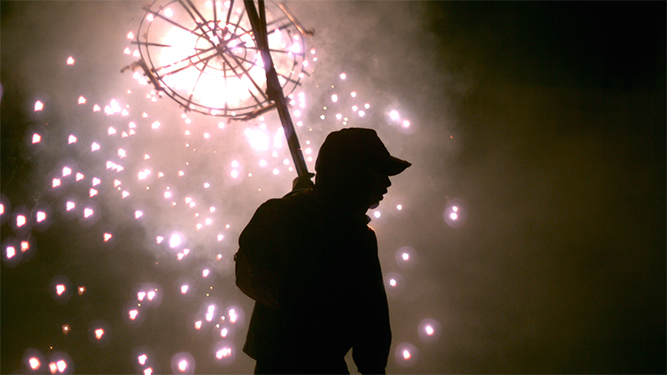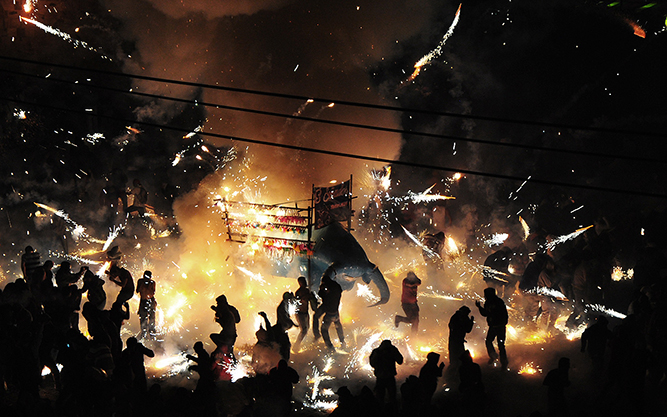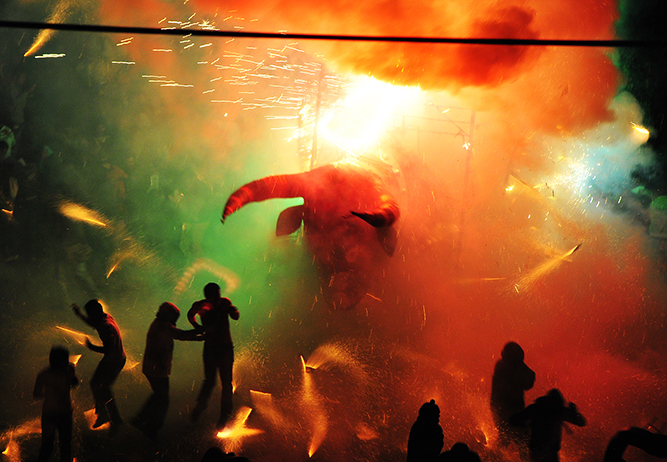Zeitlin ’04, Janvey ’06, Quinn ’05 Produce Brimstone and Glory Documentary

Brimstone and Glory is the feature-length documentary produced by Benh Zeitlin ’04, Dan Janvey ’06, Kellen Quinn ’05 and others, on the annual festival in Tultepec, Mexico, where pyrotechnics are the major industry. The weeklong celebration honors San Juan de Dios, patron saint of firework makers, and celebrates the artisans who dedicate themselves to pyrotechnics. Directed by Viktor Jakovleski, and edited by Affonso Gonçalves, the film is scored by Benh Zeitlin and Dan Romer, the two who collaborated on the Beasts of the Southern Wild score.
Dubbed “Best Documentary Feature” at the San Francisco Film Festival, Brimstone and Glory opens in theaters this fall. In preparation, Quinn spoke about this collaboration in this Q&A:
Q: What was the genesis of this project?
A: Viktor, the director, was shown some photographs of the festival by an artist who had recently been there. He was amazed but completely baffled by the images of people “raving in the fire”, as he puts it. Sometime later, during a Berlin techno party, the crowds and sensory experience reminded him of one of the images. He recognized a connection between the collective effervescence of the techno scene that is a big part of his life and the ritualistic elements of what he had seen in those pictures of Tultepec. His initial idea was a short film, but after doing an exploratory first shoot, it became clear that there was something bigger and more ambitious to be made. Ultimately, the film shot over three consecutive festivals.
Q: And what brought you in?
A: In 2014 I was just beginning to move into producing and I was eager to work with friends. Dan Janvey told me about the project and it was immediately intriguing. Also, my mother grew up in Mexico and I spent a lot of time there as a child visiting my grandmother. I felt that working on a documentary in Mexico would offer a really meaningful way of reconnecting with the country.
Q: But what was the allure of this particular project?
A.: I was intrigued by the ritual of the celebration, in which danger is a central part of the experience, and I immediately wanted to get a deeper sense of the ways in which this sort of experience brings people together—both in a social and spiritual sense. And the whole component of the festival that’s really this wild, inventive folk art fascinated me.
Q: How did you bring your audience into experiencing this?
A: We followed three people and through the course of the film, we meet up with them sporadically, the way you’d run into someone at a festival. One is a master artisan who crafts some of the most impressive toros—the enormously inventive papier-maché bulls that are the main attraction of the festival. Another was a man who builds the castillos, massive towers completely decked out in fireworks. And the third was a young boy whose family makes fireworks—a business he’s drawn to yet fearful of at the same time.
Our primary aim, though, was to offer viewers an experience of just being in the midst of the festival in all its beauty and danger. Every year on March 8—the date of the birth and death of San Juan de Dios—hundreds of the bulls I mentioned are paraded into the center of town and ignited in the middle of rollicking crowds. The fireworks explode everywhere among hundreds of people who are there to dance in the fire. We filmed there, in the center of all the madness. It’s a profoundly intense experience and the film is constructed so as to build up to it so that viewers can really feel as if they were in the middle of it. Being at the burning of the bulls was one of the most exhilarating and frightening experiences of my life.

Q: In the trailer, you’re filming from atop a huge tower being constructed out of sticks—and someone is asking for the tape. How did you get that shot?
A: The builder, who is one of our three main characters, was wearing a GoPro. The towers range from 100 to 150 feet in height and are basically made from thin boards bound together with twine and wire. Like the bulls, they are an incredible instance of people doing amazing experimentation with grand artistry—reimagining existing traditions and taking them literally to new heights.
Q: Who was the boy you followed?
A: Santi is a kid on the cusp of adulthood when Viktor met him. He was grappling with whether to go into the family fireworks business, knowing how dangerous it is. His mother doesn’t really want him to do it, but he knows his father thinks he should. And on top of that, he really has a profound love for pyrotechnics. His story through the film offers audiences a particularly male coming-of-age ritual, but at the same time, he’s an interesting surrogate for a viewer because he’s both attracted to and fearful of going into the fire.
Q: What other techniques did you use?
A.: We filmed in super slow motion, which turned exploding fireworks into something that looks like the cosmos. When Viktor and our cinematographer Tobias figured out how to shoot fireworks in that way, it opened up a visual means of conveying the transcendence that we sensed was part of the incredible ritual of the burning of the bulls. And it also just showed fireworks in a way that we had never seen them before —returning a sense of awe to something that has become a bit banal, even if fireworks still get people excited.
Q: What do you now think about Fourth of July fireworks?
A: In Tultepec, people are more frequently in the fireworks, rather than looking up at them. You get a different sense of the rhythm and complexity of pyrotechnics—spinning wheels on the castillos, smoke interacting with the flashes of lights. I’ve come to appreciate pyrotechnics in a whole new way.

Q: What do you hope for the film?
A: We made the film for a big screen experience. It’s being released in the U.S. and Canada by Oscilloscope and beyond screenings in cinemas around the country, we want to bring it to science and art museums and other venues where people can come together to see it big and loud. We also hope to have screenings with Benh Zeitlin and Dan Romer’s incredible score performed live.
Q: And what is “Wesleyan” about this?
A: I think Brimstone & Glory is a film that reflects the liberal education in some interesting ways: It’s an experiential film that also offers a form of anthropological investigation, but in a non-academic sense. At the same time, it’s a visual experiment that’s deeply entwined with music. And it’s meant to be a celebration of a very distinct culture and of the cinematic experience itself. It suggests one version of what a multidisciplinary approach to life can be. Intellectually, we didn’t set out with that goal, but the result reflects the interesting eclecticism of thinking about story, aesthetics, and cinema—and the importance of sharing experiences with other people.
It’s a reflection of us working together—and the world of Wesleyan can appreciate those intersecting themes and ideas.

